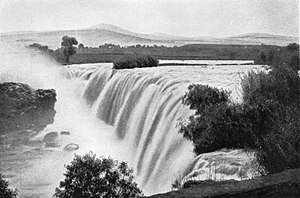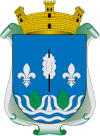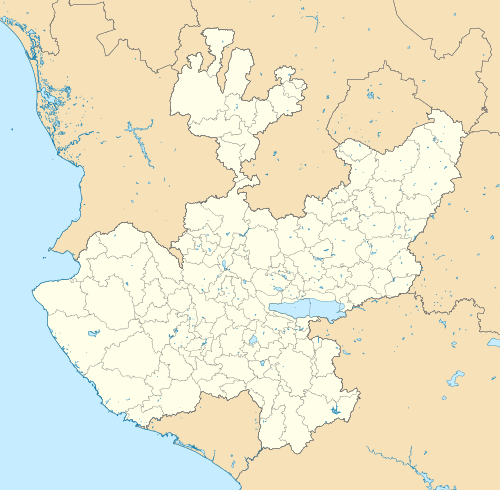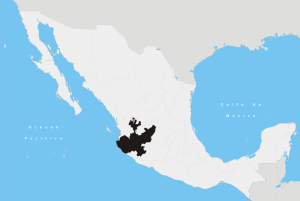El Salto, Jalisco
El Salto is a city, and the surrounding municipality of the same name, in the central region of the Mexican state of Jalisco.
El Salto | |
|---|---|
Municipality and city | |
 El Salto de Juanacatlán, circa 1909 | |
 Coat of arms | |
.png) Location of the municipality in Jalisco | |
 El Salto Location in Mexico  El Salto El Salto (Mexico) | |
| Coordinates: 20°51′13″N 103°18′14″W | |
| Country | |
| State | Jalisco |
| Area | |
| • Total | 41.5 km2 (16.0 sq mi) |
| Population (2010)[1] | |
| • Total | 138,226 |
| • Density | 3,300/km2 (8,600/sq mi) |
| Website | www |
The municipality covers a surface of area of 41.50 km2 (16.02 sq mi) with a population of 138,226. It is surrounded, in a clockwise direction from the north, by the municipalities of Tlaquepaque, Tonalá, Juanacatlán, and Tlajomulco de Zúñiga. It was created on 22 December 1943, with its excision from the municipality of Juanacatlán.[2]
History
In 1530, the Spanish conqueror of Mexico, Hernán Cortés, commissioned Nuño de Guzmán to conquer "inland". This part to the conquest of the kingdom of Michoacán, venturing to conquer new lands was launched towards the West. Thus, on January 20, 1530, the expedition crosses the Lerma river through Cuitzeo and walking northwest, appears in front of Tonalá on March 24, taking possession of the village, one of the largest in the region, leaving the entire region subjugated to the Spanish kingdom. The next day, March 25, Nuño de Guzmán, takes possession in the name of the King of Spain from the regions south of the Santiago River and north and west of Lake Chapala, reserving for himself the title of entrustment, taking over the Valleys of Toluquilla and Tonalá.[3] Diego de Porres Baranda, one of the richest men in Nueva Galicia who had acquired his first lands in the Cocula Valley in 1580 and had become one of the most important food suppliers of Guadalajara in the first decade of the century XVII, in a real hearing held on February 30, 1606, receives a Mayorazgo according to the command agreed by the President of the Royal Audience Don Alonso Pérez Mechana, in which he was granted “a place of stay for small and five cattle Knights of land in the jurisdiction of the town and Santa Fe Valley, between this and Juanacatlán.[3][4] In the seventeenth century the Toluquilla hacienda extended from the town of Analco to the waterfall of El Salto de Juanacatlán and was one of the largest estates belonged to the Company of Jesus or Jesuitas, religious institute of clergy .[3] In June of 1767, the King Carlos III, promulgates his Royal Decree, where he expels all the clerics of the Company of Jesus, Spanish Territory, leaving the Treasury of Toluquilla in the hands of Mr. Francisco Javier de Vizcarra, first Marquis of Pánuco.[3] In 1818, the existence of the "Jesús María" estate is recorded. The hacienda had a very special characteristic, there was the famous Juanacatlán Falls, an impressive waterfall that the large river of Santiago makes in this place. That fall that reached almost twenty meters high and whose curtain was over a hundred and thirty meters long.[5] In 1836, Don Francisco Martínez Negrete Ortiz de Rozas, a Basque immigrant from Lanestosa, Viscaya region in Spain and a very important merchant from the era in Guadalajara,[6] acquires the Treasury of "El Castillo". The lands are transformed into irrigation lands taking advantage of the waters of the Rio Grande Santiago and planting cane, chickpea and alfalfa. On the left bank of the Rio Grande Santiago, near the water fall, a trapiche moved by animal force was installed and the water was channeled to irrigate the cane grooves. Once the product was finished, it was transported to Guadalajara in carts pulled by oxen. This place was called the farm "El Molino". With the ranch "El Castillo" and later the Hacienda de "Jesús María", the ranch "La Azucena" and the Hacienda de "El Molino" formed what is now known as El Salto.[3][5] When Francisco Martínez Negrete Ortiz de Rozas dies, the estates with an extension of 12,319 hectares are inherited by his eldest daughter María Dolores Martínez Negrete y Alba, married to José María Bermejillo Ybarra, a prosperous merchant and Spanish businessman from the town of Balmaseda in the Viscaya region in Spain.[7]
Pollution
The municipality of El Salto is located on the banks of Rio Grande de Santiago, one of the largest and most polluted in the country. Its waters are loaded with waste from the large factories of the industrial corridor and coming from the Guadalajara Metropolitan Area. The construction of the retaining wall at the top of the waterfall, which was used to channel the water to the hydroelectric plant, conserves the contaminated water that ends up stagnant, retaining toxic sludge and becoming a focus of infection and swarms of mosquitoes that They attack the population and transmit diseases. The pestilence of water and its high level of pollutants ends up torrentially affecting the health of the inhabitants, since it can be said that in El Salto there is neither water nor clean air, affecting the flora, fauna and fertility of the place in the same way . Among the main health effects that occur in the municipality are: congenital malformations, abortions, allergies, respiratory infections, bronchial asthma, leukemia, lymphomas, renal insufficiency, urticaria, conjunctivitis, vertigo, chronic headache, among others.[8]
Music
In El Salto Jalisco, it has been characterized by hosting musical groups with a lot of popularity, either inside and outside the municipality, such as:
'Bands'
- The Dominant Band El Cerrito
- Youth Star Band
- Banda Los Chicos Tambora
- Los Rosalitos Band
'Groups'
- Latin Renewal Group
- Tropical Latino Group
- Latin Rhythm Group
- Latin Monkeys
- Argos
- Sonora Tattoo (from Juanacatlan, Jalisco, neighboring municipality).
Parties
'Civil holidays'
- Anniversary of the Independence of Mexico: September 16.
- Anniversary of the Mexican Revolution: November 20.
Religious festivals
- Holy Week: Thursday and Good Friday.
- Feast in honor of the Admirable Virgin Mother: from October 12 to October 20.
- Festivities in honor of the Holy Cross of La Parroquia La Santa Cruz In El Salto: from April 25 to May 3.
- Festivities in honor of San Isidro Labrador, in the Pints: From May 7 to 15.
- Festivities in honor of San Jose, in San José del Castillo: March 11–19.
Illustrious characters
Some illustrious characters of El Salto are[9]
- José de Jesús Limón: Bachelor and Governor of Jalisco
- Mike Laure: Singer, songwriter and actor.
- Concepción Becerra de Celis: Teacher and director of Jalisco Normal School.
- Pedro Valadez "Peyul": Activist and promoter of gender equality.
Activist groups
Caution Collective,[10] a group of citizens with initiative to change. Created in January 2011, it aims to improve the quality of life of the inhabitants of Salta with the promotion of culture and the arts, and that citizens demonstrate their skills, their desire to live in a better environment, their strength to face social problems and desires to contribute to the formation of the identity of the municipality.
Government
Its form of government is democratic make up 16 councilors, who with a simple majority make decisions about the municipality, are 6 opposition councilors and 10 of the ruling party. It depends on state government and federal; elections are held every 3 years.
2012 political crisis
The municipality of El Salto suffered a great polarization because of the municipal elections of July 1, 2012, where the inhabitants accused a candidate and his family of caciques.[11] The candidate Joel González Diaz was criticized because since 2007 he and his brother Gerardo González ordered Martín Ruvalcaba to be killed and the mayor of the municipality, Joel González Díaz, passed to each other in 2012 and registered his candidacy for municipal president for the second time.[12]
Multiple reports of abuse of authority, arrogance and mistreatment were made by the opposition candidates, but these were never able to curb the candidacy of Joel González Díaz, it was when an opposition group was consolidated, from various sectors of the opposition, its purpose was to prevent that Joel González Díaz will again take the municipal presidency.[13]
Despite all the results of the municipal elections[14] was the following:
- Institutional Revolutionary Party Green Ecologist Party of Mexico 22,143 votes
- National Action Party 19,393 votes
- Citizen Movement (political party) Labor Party (Mexico) 11,070 votes
Despite challenges, and the July 2 march that brought together 10,000 opponents of the state court,[15] handed down his sentence in favor of Joel González Díaz for what he was legitimized since in reality there were no more than five hundred protesters.
Hydrography
The municipality belongs to the Lerma-Santiago hydrological region.[16] Its hydrological resources are provided by several rivers and streams that are part of the sub-basin Santiago river (Verde-Atotonilco), belonging to the hydrological region Lerma-Chapala-Santiago. The main river is Santiago where the waterfall of El Salto de Juanacatlán is located. There are also the Ahogado stream and some springs, such as that of Cerro Colorado and de la Cruz.
The Santiago River is one of the 11 most polluted rivers in the country, according to the National Water Commission (Conagua). The main sources of pollution are sewage from homes and hundreds of industrial discharges. The serious consequence of this contamination is the damage to people's health. The 120 thousand inhabitants of El Salto and Juanacatlán suffer from it with frequent conditions. The death of the river began about 40 years ago. In 1971 the first effects of the serious contamination appeared. Where before was the famous waterfall known as the "Mexican Niagara", now there is brown water that drags white foam, which in times of air flies and spreads.[17]
References
- http://www.microrregiones.gob.mx/catloc/Default.aspx?buscar=1&tipo=nombre&campo=mun&valor=el%20salto&varent=14
- Chronology of El Salto
- Manuel Salas Mercado - El Cronista Municipal El Salto. "El Salto and its History (Historical Facts)" (PDF). Retrieved February 24, 2013.
- Van Young, Eric. Hacienda And Market in Eighteenth-Century Mexico: The rural economy of the Guadalajara Region 1675-1820. Rowman & Littlefield Publishers.
- Manuel Salas Mercado - El Cronista Municipal El Salto. "El Salto and its History (Chronology)" (PDF). Archived from the original (PDF) on September 6, 2015. Retrieved February 24, 2013.
- Gladys Lizama Silva. "Los Martínez Negrete in the 19th Century" (PDF) (in Spanish). Retrieved February 23, 2013.
- Tayra González Orea. "Methods of agricultural financing in Mexico: the case of the banking firm Bermejillo y Cía. 1848-1860".
- McCulligh; Páez-Vieyra; Moya-García (2007). Martyrs of the Santiago River: report on violations of the right to health and a healthy environment in Juanacatlán and El Salto, Jalisco, Mexico. Martyrs of the Santiago River: Report on Violations of the Right to Health and to a Medium Healthy Environment in Juanacatlán and el Salto, Jalisco, Mexico. hdl:11117/5338.
- "www.paginasprodigy.com/iee_elsalto/Personajes.pdf" (PDF). Archived from the original (PDF) on 2013-12-30. Retrieved 2019-09-04.
- Caution Collective, www.colectivoprecaucion.org
- https://web.archive.org/web/20131230232939/http://www.proyectodiez.mx/2012/07/05/hermanos-gonzalez-diaz-historia-de-un-cacicazgo-en-el-salto-jalicso/16669
- http://www.proceso.com.mx/?p=325982
- http://www.proyectodiez.mx/2012/08/20/dispuestos-en-el-salto-a-dar-la-la vida-to-end-with-cacicazgo-priista/20598
- "ceprep2012.iepcjalisco.org.mx". Archived from the original on 2013-12-05. Retrieved 2019-09-04.
- http://www.informador.com.mx/jalisco/2012/389347/6/vecinos-de-the-jump-manifest-before-the-electoral-court.htm
- INEGI (2008). "Map of Hydrological Regions". Archived from the original on June 12, 2009. Retrieved October 8, 2008.
- Liliana, Alcántara (January 22, 2012). "Las Turbias Aguas del Niagara Mexicano". El Universal. Retrieved February 24, 2013.
